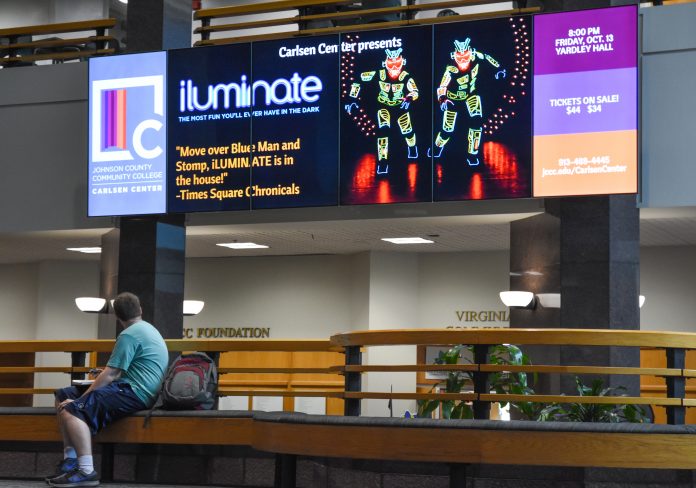
Connor Heaton
Reporting Correspondent
Many consider the Carlsen Center the main hub of the college, as students and newcomers alike gather to get information about the school and upcoming performances. As such, it’s important to make a great first impression. Enter the Carlsen Center Atrium Digital Displays- a massive array of six wide-screen TVs and one of the college’s newest technological investments.
Rex Hays, associate vice president of campus services and facility planning, said the college spent $67,173 on this project.
The screens work both separately and in tandem with one another, airing news bulletins about upcoming performances and photos of various college events.
Molly Baumgardner, communications director, explained why having this display is integral to the identity of the Carlsen Center and the college as a whole, because while primarily used as an advertising device for upcoming performances and events, she refers to it as a storytelling device.
“We wanted to see if there was a way for us visually to tell more of a story about JCCC, so rather than them seeing just a little appetizer, we wanted them to see more of a full menu,” Baumgardner said. “When you go to a restaurant, did the food they delivered to your table actually look like what was advertised? That’s why we think what better way to tell the story than our students, faculty and staff going about doing what we do every day. ”
The multi-thousand dollar project began in spring 2017 by bringing in architects and designers as a pair of fresh eyes, looking for new and different ways to better utilize space.
Before the new displays, the college had a smaller screen that showed the same information; however Baumgardner said it looked like a postage stamp in relation to the three-story atrium.
Space wasn’t the only thing designers considered when setting up the display, as Ron Brunkow, video systems engineer, said a lot of it was planning to figure out the desired specifications
A major part of this was considering the enormous amount of weight and stress such an object would exert on the wall. Originally, when contractors built the framework, it didn’t fit with the pillars, so they had to rebuild it from the ground up.
Ron Brunkow, video systems engineer, recounts details of how they set it up.
“The contractors found concrete behind the sheet-rocked area of install, built a substructure to bolt into the concrete,” Brunkow said. “The separate monitors were then bolted to the monitor mounts.”
Once the mounting issues were resolved, organizers were faced with a new problem– what would the screens display? Due to the display’s massive size, standard resolution images would not be compatible.
“There is a bit of a learning curve on driving the equipment and to create content to fill an un-standard aspect ratio,” Brunkow said. “For example, a standard ratio would be 16×9, this aspect ratio is 27×8, so zones of content are used to fill the overall video wall canvas to create something aesthetically pleasing and to advertise.”
Though she has big plans for the future, as of right now, Baumgardner says the monitors show advertisements for college events and showcase the work of college photographer Susan McSpadden.
“[McSpadden] is the number one ranked female photographer and so we’re really proud of what she does,” Baumgardner said. ”What you see in college brochures and what you will see on the monitor are Susan’s work. She primarily takes stills but she uses an excellent DSLR which allows her to take a notably high resolution would allow her to take high resolution video.”
Even with the displays at full capacity, there are plenty of things to tweak, fine-tune and improve.
“Where I see that we’ll be doing some changes is regarding the type of media that we’re looking at,” Baumgardner said. “Perhaps in the future there will be more of an emphasis on video inter-spliced with photos.”
Baumgardner also said she was planning on adjusting the video timelines, testing them out to minimize viewer fatigue.
“That’s one of the things that we’re going on kind of assess is how long can we go with the loop how long should each slide be on there for it to have that impact,” Baumgardner said.
The future seems bright with the monitor as Baumgardner explains some more adjustments that could be made later on, like adding a constant news stream or temperature gauge always flowing at the bottom.
“We really haven’t said a definitive yes or no either way. I think that’s something that we’re just going to kind of test drive,” Baumgardner said.
Aside from adjustments, some wonder what other uses the monitor may have. Baumgardner said it was possible to air student art, news alerts and sports events, though rarely.
“It’s going to be one of those things we look at as time passes, there might be some changes for that but we never close the door on what might be in the future because I can remember a campus when we didn’t have monitors at all,” Baumgardner said.





















